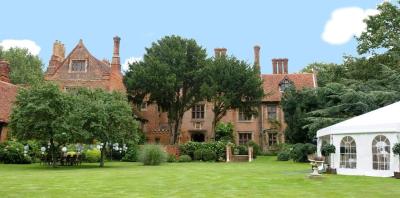Creeksea Place

Photo courtesy of Creeksea Place
Creeksea Place is a large red brick
house standing in a park of about 30 acres. The original
building was built in about 1569 by Sir Arthur Harris ( or
Harrys) who was a member of the Mildmay family.
The south range was destroyed in 1740 and only the east and
north wings now survive.
The north wing retains some original features including an
original rain water head which is dated 1569 ,
windows,chimneystack's and an original staircase.
The water head is used to date Creeksea Place as records show
that it was not in place in 1508 but was listed as a building in
1594.
The East wing was rebuilt in 1901 on the foundations of the old
structure by William Rome who was the occupant having purchased
it from the Mildmay family.
Lord Mildmay, Keeper of the Crown Jewels for King Charles 1st
married into the Harris family and eventually became the owner
of Creeksea Place.
He is reputed to have been one of the twelve State elders who
subsequently signed King Charles 1st death warrant. Following
the execution and after the accession to the throne of King
Charles 2nd , Lord Mildmay was said to have been arrested at
Creeksea and he and the other eleven elders were accused of
regicide ( the murder of a king or queen ), later pardoned but
it is said, to make sure they did not forget the enormity of
their crime, all twelve were obliged to spend the anniversary
date of the King’s execution in the Tower of London.
The Great Sword of Creeksea Place had rested for nearly three
hundred years on a platform at the head of the oak spiral
staircase which led up to the attics of the old house. It a
court sword of the early 17th century, its hilt and pommel being
covered with chased silver in various designs, the Tudor rose
being the most prominent.
It is said that one man alone, with the sword in his hand, could
have held the stairs against all comers, and protected the women
and children of the house from assailants. The Great Sword is
now mounted in a display case in nearby Creeksea church.
In 1940 Lindisfarne College moved from its home at Westcliff to
Creeksea Place until the Military requisitioned the place as a
wartime base and training unit at which point the school
transferred to Newburgh Priory at Coxwold in Yorkshire until
1950 it again moved to a permanent home in Wynnstay ,North Wales
Following the end of the war the
main building has been largely uninhabited until recent times
when it has been used as a conference centre and film location.
The building has became a familiar feature on Britain's screens
as it provides the period location for many programs on
television and films.
Creeksea Place is now open to the public as a conference centre and Wedding Venue
Local Legends about Creeksea Place
Creeksea Place was reputed to have been the home of Anne Boleyn
and that her spirit was said to have been seen walking from the
old cottage near the Creeksea ferry.
Her daughter, Queen Elizabeth, is said to have met her soldiers here and that they were supposed to have come to meet her through a subterranean tunnel connected with Rochford Great Tudor drains, full of oyster shells have been uncovered but not the tunnel itself.
Although the story of Anne Boleyn is attractive, if the hall was
built in 1569 the fact that Anne was executed in 1536 would mean
that she could not have visited. However there may be some truth
to the story as in 1500 the Harris family who built Creeksea
Place were landowners at Rochford on the other side of the
water.
Given that the Boleyn family were the
other large landowners in Rochford it is very likely that Anne
would have known the Harris's as the one local family in her
social class. Records show that the Boleyn family at one time
also owned the land at Creeksea and that there was an active
ferry across the River Crouch from Creeksea to Rochford.
Whilst there was no record of any building substantial enough
for Anne to have visited it is possible that a young Anne used
the ferry to visit her neighbours land.
The story of the tunnel is also unlikely given the width of the
River Crouch at this point and the difficulty in shoring up,
draining and ventilating such a long tunnel with the engineering
skills available in the 1500's.
There is a tunnel leading underground at Creeksea Place but this
leads to an old ice room which was used to store ice for long
periods before the advent of freezers.
This period was one of intrigue and religious persecution with priest holes and escape tunnels often found in large houses to enable the escape of the occupants or embarrassing visitors should the forces of state or church arrive. It is probable that such an small escape route was embellished locally to produce the tunnel legend.

Clicking
here will take you to theCreeksea Place web site which includes
photographs.
